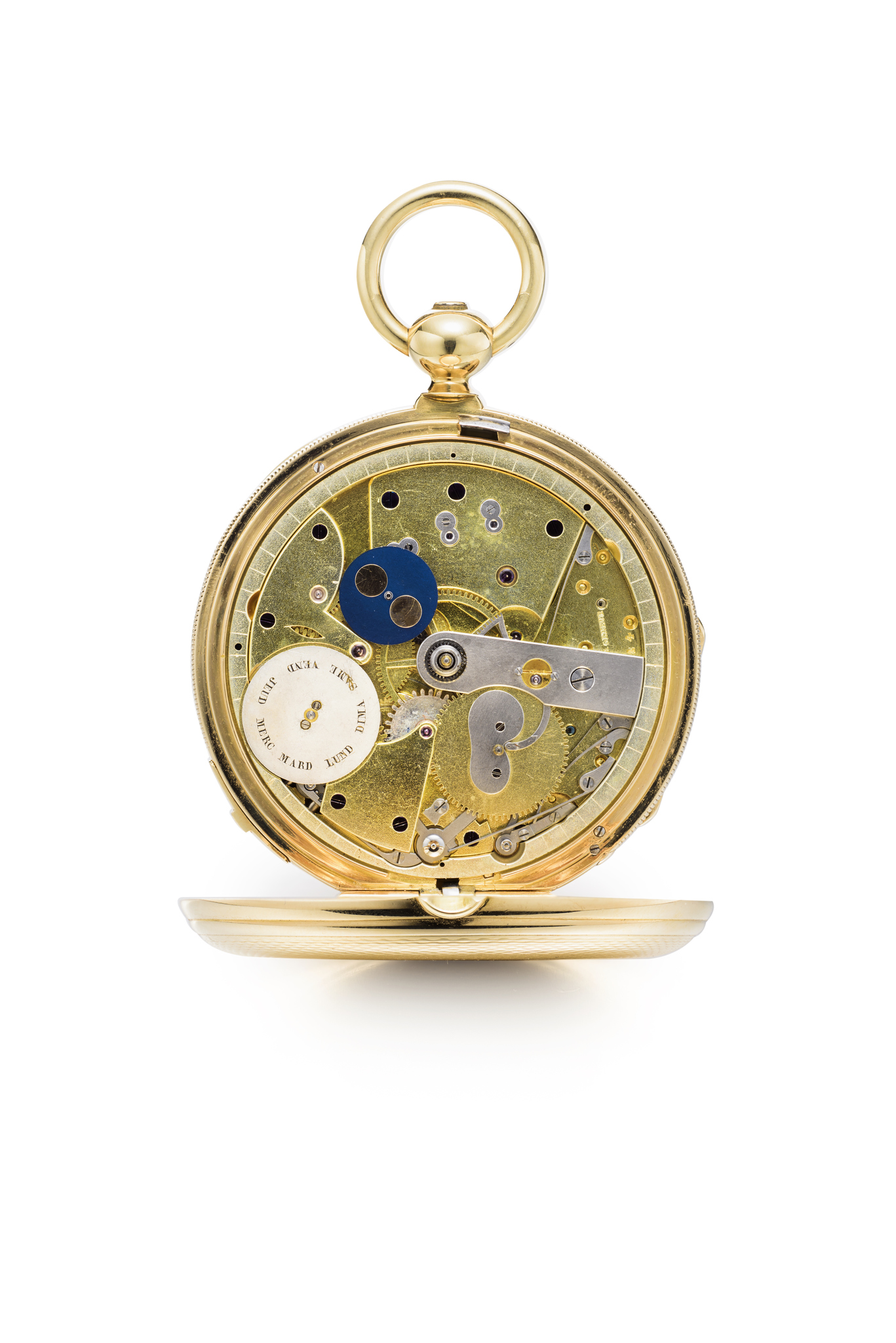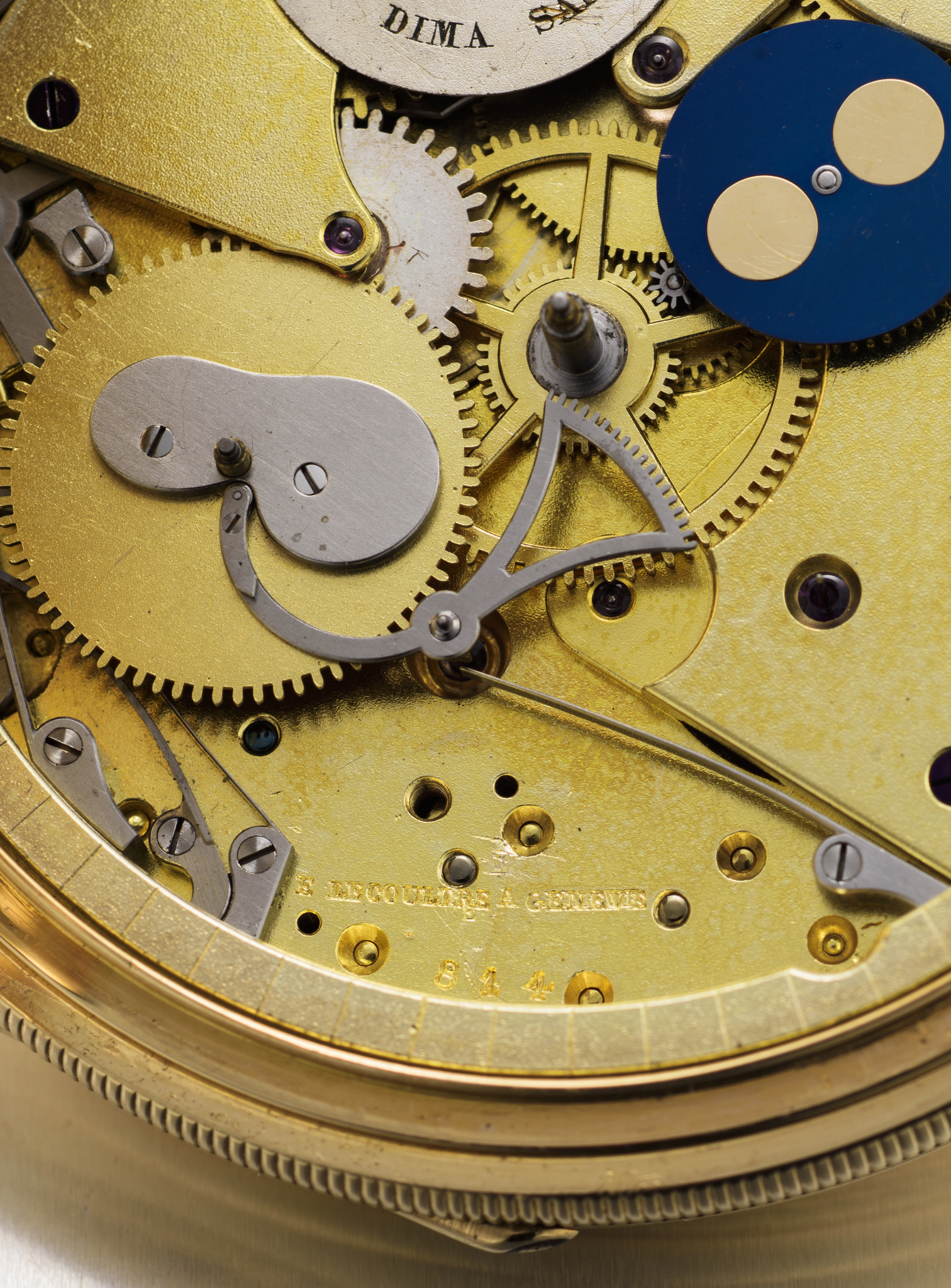Notes
Eugène Lecoultre’s triple calendar with moon phases and equation of time In this watch, Eugène Lecoultre (1819-1882) created an ingenious date adjustment system. We have to do at the base to a watch with a triple date, whose duration of each month is 31 days, like all the rare watches of the time which are then fitted with this kind of horological complications Eugène Lecoultre's system allows the end of each month to quickly correct this date manually by going both forward and backward! Moreover, this correction of the date automatically leads to the adjustment of the day of the week but also of the phase of the moon. Even more complex, this correction does not alter the system of the equation of time (whose the cam makes a turn in a year) but also adjusts it! Everything is achieved through a mechanical device that can be seen on the left side of the movement. It is for the time one of the most sophisticated calendar watches, independently of some previous achievements of Abraham-Louis Breguet (1747-1823) and perpetual calendar watches with retrograde date of which Eugène Lecoultre had made a specialty in Geneva. It is only in 1860-1862 that Charles-Henri Audemars (1829-1906), last son of Louis Audemars (1782-1833) will realize in the Vallée de Joux his famous perpetual calendar with indication of the leap year. This last type of calendar with the indication of the exact duration of each month for the 48 months of the cycle, including February 29 every four years, will replace the watches with retrograde perpetual calendar (more delicate of use and more expensive in manufacturing cost) and will be gradually impose in the watch industry. Lecoultre, Eugène (1819-1882) Eugène-Constant Lecoultre (originally from Le Chenit, Vallée de Joux) married in 1842, in Geneva, Louise-Jacqueline-Simone Soldano (1820-1858), precision timekeeper adjuster; the couple has three children. He spouse, in second weddings, in 1861, Eglantine Cellier (1838-1924); the couple has 14 children, at least six of whom arrive in adulthood. He seems to open his worshop in Geneva in 1848. He manufactures watches with horological complications, very neat, including those with a retrograde perpetual calendar that seems to his invention. He also looks after the precision adjustment of watches. In 1880, he won a First prize at the timing contest of the Geneva Astronomical Observatory (for a chronometer with lever escapement, Breguet hairspring, set by himself, No. 2 370, with 192.3 points). He is mentioned in Geneva as a manufacturer, adjuster and watchmaker-merchant (in 1848, 1857, 1862, 1874, etc.), under the trade-names Lecoultre-Soldano, Lecoultre-Cellier, and Lecoultre & Cie. He was located in Geneva, 8, rue François Bonivard, at the foot of the Saint-Gervais district, on the right bank of Lake Geneva A watch with minute-repeater, chronograph and retrograde perpetual calendar, signed by him, was sold by Antiquorum, Geneva, April 18, 1998, lot 561, for the amount of CHF 35 650.- His eldest son (from the first marriage), Marius Lecoultre (1847-1915) works with him and takes over the paternal affair; it is to him that we owe the invention of watches known as “Boules de Genève”. Note that the relationship between Eugène-Constant Lecoultre (1819-1882) of Geneva and Charles-Antoine LeCoultre (1803-1881) of the Vallée de Joux ?? founder of what is today the the Jaeger-LeCoultre manufacture on Le Sentier - dates back to eight generations,with the “honorable” Pierre (I) Le Coultre (circa 1532 ?? circa 1602). Equation of time An equation of time watch shows the difference between “true” solar time (that of Nature) and “mean” solar time (that of Man). This rare horological complication is usually combined with other “astronomical” indications. The Earth makes an elliptical orbit around the Sun; also, its axis is tilted from perpendicular to the plane of the equator. For these two reasons, a “true” solar day, which is the interval of time between two “true” noons when the Sun is at its highest point in the sky, is never the same length over the course of the year. It’s exactly 24 hours long on just four days: April 15th, June 14th, September 1st and December 24th. In an unchanging cycle, all the other days are either longer or shorter. This difference, which ranges from less 16 minutes and 23 seconds on November 4th to plus 14 minutes and 22 seconds on February 11th, is the “equation of time”. Watchmakers have always vied to find ingenious ways to convey these celestial mechanics. Because these variations occur identically on the same dates, they can be “programmed” by means of a cam making one complete rotation each year. This extremely sophisticated horological complication first appeared on long-case clocks. It was then miniaturised to fit inside a pocket watch and later, in the 20th century, a wristwatch. Rarely seen alone, the equation of time is a “classic” feature of any “ultracomplicated” watch. There are different ways to show the equation of time. Most watches prefer a hand sweeping a subsidiary dial or arc, graduated from 16 to + 14 minutes. This requires a little mental arithmetic by the wearer, adding or subtracting to calculate true time from mean time. Simpler to use but more complex to make, the “running equation” (équation marchante) has two coaxial minute hands, one to show mean solar time and the other true solar time at a glance. For many years this sophisticated system was found only on pocket watches, although the first wristwatches with running equation were recently unveiled. On the subject of innovations, watchmakers have devised systems for reading the equation of time at a specific longitude and not for an entire time zone, thereby further enhancing precision.






